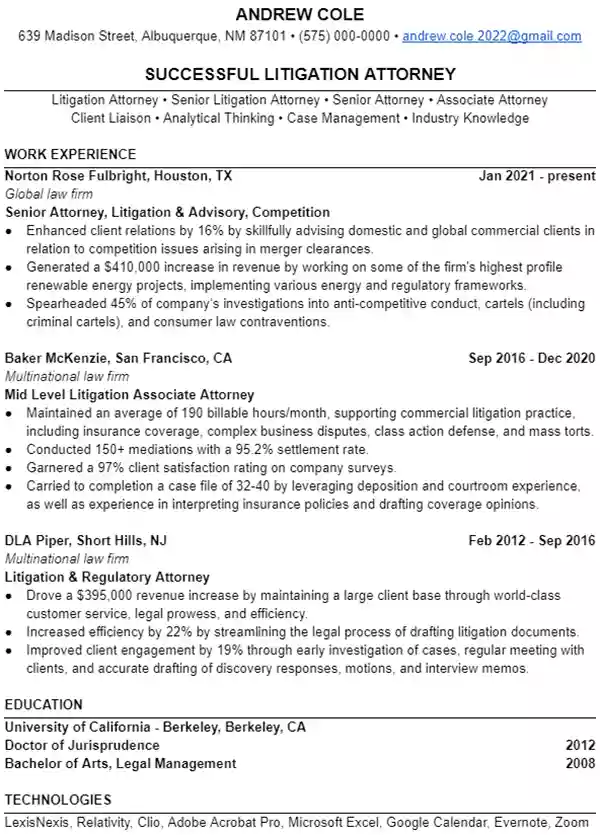Attorney Resume Example
A resume template and step-by-step guide for attorneys by Leet Resumes.


The Attorney Resume that Gets Interviews
Your job relies on research and communication. Whether it’s spoken or written, it’s your job to check every detail and every letter of the law to ensure your clients are in the most advantageous position and make sure the other side knows it.
In a room with a recruiter, chances are you can win the game of mental chess and get the job offer you desire right then and there. But to get to the interview, you’ll need a resume that speaks directly to your recruiter and convinces them to learn more about you and your career.
Fortunately, you’ve landed in just the right place.
In this resume template and guide, we’ll show you how to use your communication skills, attention to detail, and research skills to win more interviews and job offers.
Here’s what’s included to help you along the way:
- A step-by-step guide and resume template
- A resume example specifically made for an attorney
- Helpful resume tips to seal the deal and land an interview
Or, have Leet Resumes write your resume for you…for free!
Take a Recess
Prefer to have someone else write your resume? That’s an option, too. If you’ve already read hundreds of pages this week (or today), stop right here. The experts who wrote this guide will write a custom attorney resume for you. Better yet, they’ll do it for free (though tips are much appreciated). Try them out for yourself. {Link}
What to Include in an Attorney Resume
The sections of your resume are pretty boilerplate. It’s the details you’ll include that set you apart from the rest of the competition. In your resume, you’ll include:
- Name + Contact
- Professional Headline
- Summary
- Work Experience
- Education
- Keywords
We’ll cover what to include in each section, but first, let’s talk about structure.
How to Format Your Resume
Simple is best
Sorry to break the news, but your resume isn’t the place to finally create a visually compelling document. While it’s no pleading paper, the most effective resume is pretty pattern in form.
Rather than distracting with multiple columns, fonts or colors, keep the argument front and center in the simple single-column format you see in the resume example. It’s nothing fancy, but it gets the job done…that is, it gets you closer to a ruling in your favor (a.k.a. The Interview).
No paragraphs, please
This isn’t the place for convoluted circle talk or wordy forms. Use your limited space to speak your point concisely and directly.
Instead of paragraphs, you’ll use keywords, lists and bullet points. A resume that’s easy to scan lets your recruiter learn more about you, and why you’re the best fit for their open attorney position.
Name + Contact
First things first, type your full name at the top center of the page. There’s a reason why the case caption is prominently displayed first, and the same goes for your resume: the recruiter needs to know who to contact for an interview if they like the contents of your resume.
Choose a font that’s professional and legible, and make your name slightly larger than the rest of the text.
Directly underneath, add your contact information: phone number, email address and location (just the city and state will do).
Anything you include on your resume is admissible for judgment. That goes for your email address, too.
If your email displays anything other than the kind of professionalism you’re expected to bring to the organization or firm, swap it out for the classic firstname_lastname approach instead.
Professional Headline
Your opening statement can make or break a case. The way you present the information in your professional headline creates biases in and against your favor. Luckily, there’s a tried and true formula to help:
Flattering adjective + level of experience + official title
The goal is to capture their attention in three to five words and make your recruiter buy-in. These three items tell a recruiter all they need to know if you’re a good fit for the open position.
Choose a slightly flattering adjective that puts you in a positive light, like thorough, passionate, professional or committed.
Then add a word to describe your level of experience: associate, partner, counsel, junior, senior, etc.
Finally, add your official title (and any specialized area of the law you serve).
When it’s all said and done, you should have something that looks like this: Strategic Junior Associate Attorney.
Professional Summary
Once your opening headline has drawn their attention, your professional summary highlights the most relevant evidence to showcase your compatibility with the open position.
As you’ll see in the resume example, this doesn’t include any paragraphs or sentences, just four single-lined lists.
In the first line, list all the job titles you’d accept for your next attorney position. Most importantly, add the exact title for the role you’re applying to.
In the second line, list the skills and attributes that qualify you for this specific role. Because of the limited space, narrow your selection to hyper-relevant skills that paint you as the prime candidate for the position. A great way to decide what to include is by referring to the original job listing.
The third and fourth lines are optional, so don’t feel bad if you can’t think of anything to fill them. Lines one and two are enough to get you in the interview where your exemplary communication skills can win you the job.
In line three, list your career highlights and achievements (notable cases, firms, research, etc.).
And in line four, list the awards and promotions you’ve received throughout your attorney career.
Sidebar: still hanging in there?
We get it, you deal with enough reading, research and writing as it is. If you’d rather take the night off and leave it to the experts, Leet Resumes will write a professional attorney resume for you…and they’ll do it for free. (Tips for a job well done are always appreciated.)
Work Experience
As an attorney, your wins and losses are much more apparent than in other professions which makes the work experience section of your resume template easy.
Instead of listing your daily tasks and duties as an attorney, use this space to highlight the results you bring to whichever organization you work for. Here, you’ll tell the story of your successful career chronologically, putting an extra emphasis on these three items:
Success Verbs
These are actions that imply a positive outcome before you reveal any details. For example: boosted, advanced, capitalized, acquired, reduced or negotiated.
Start every bullet point entry with a strong success verb so your work experience reads like a highlight reel of success.
Numbers
Numbers clear up any convolution and give your potential employer an immediate visual of the success you might bring to their organization. The most important metrics to include in your resume are anything pecuniary: How did your work save the company or the firm money?
Did you prevent millions from being spent on legal fees by avoiding trial? Or maybe you renegotiated a long-term contract that added tens of thousands more in revenue.
It’s important to include as many numbers as possible to build a clear case: you’re the prime candidate for the position.
When you think you’ve added all the numbers you can, go back and try to double the amount again. Each metric brings you that much closer to an interview.
Promotions
Promotions show your success from the account of a first-hand witness. Instead of recounting your own experience, each promotion shows that others have believed in your skills and talents and have rewarded you for it.
With that said, include every promotion you’ve received – this isn’t the time to be shy, now.
Education
Here, you’ll factually display your educational background. Stick to the facts, clean and simple, and refer to the resume example for formatting:
Where you attended school Dates of attendance Degree(s) obtained Honors and awards
Extracurricular activities and affiliations are moot on your resume. Keep the emphasis on your career and save the rest for the post-interview banter with your future employer.
Keywords and Skills for an Attorney Resume
In the final section of your attorney resume template is a list of keywords to let the recruiter easily draw their own conclusion that you’re a highly-qualified and very compatible candidate for their open position.
Include a combination of skills from the categories below. Here are a few examples to get you started, but always add your own according to your expertise:
Soft Skills that highlight your interpersonal contributions and representation of an organization.
- Strong Written and Verbal Communication
- Self-Starter
- Attention to Detail
- Team Player
- Critical Thinking
- Project Management
Technical Skills and Specializations for the attorney role you’re applying for.
- Negotiation
- Contract Law
- Litigation
- Public Speaking
- Document Management
- Discovery
Technologies used in your work.
- Microsoft Office 365
- ProLaw
- Summation
- Trial Director
With your final attorney keywords, skills and technologies in place, your resume is complete and ready to send.
Can someone else write my resume for me?
Glad you asked. The experts behind this resume example and guide can write yours for free (seriously!). Tips are welcomed and appreciated.










